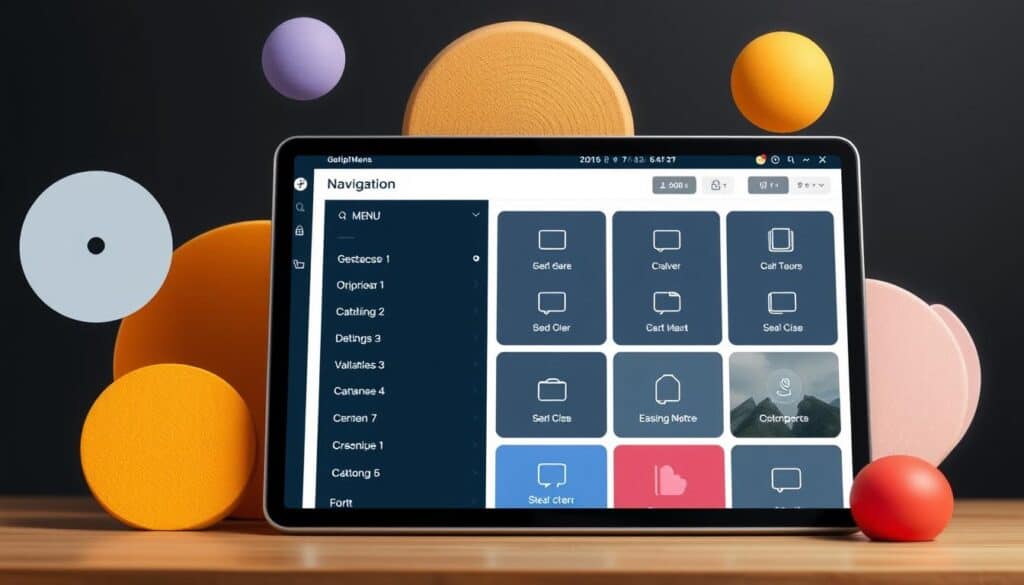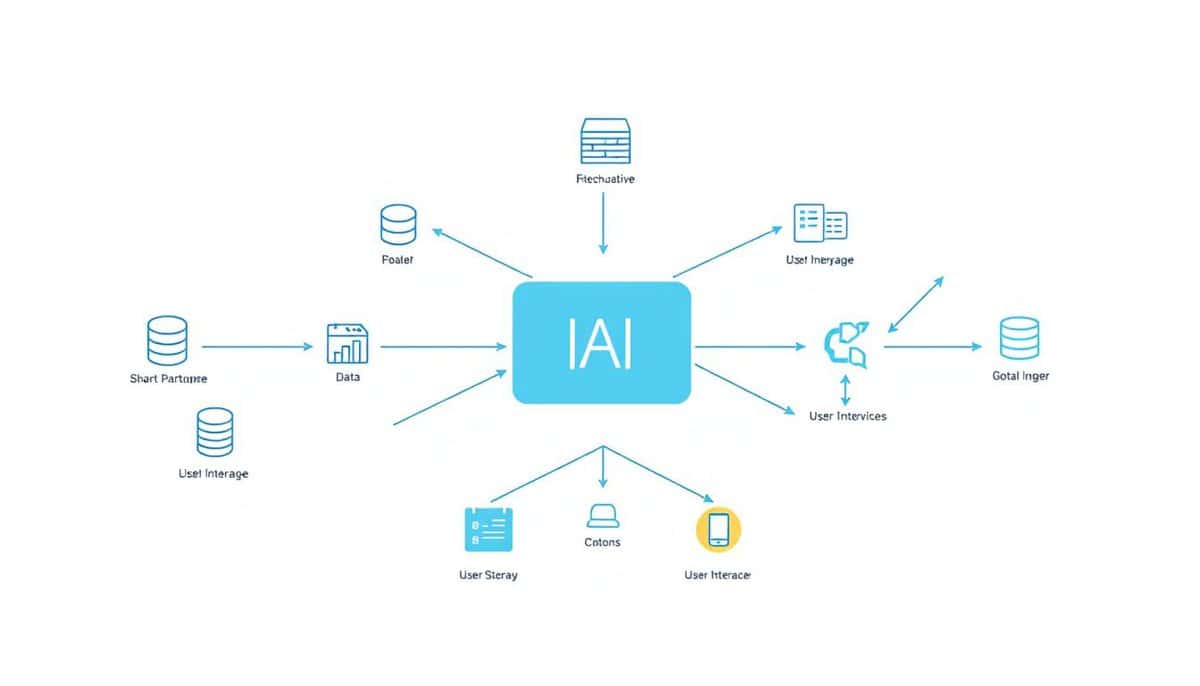Have you ever wondered why some websites are so easy to use and others are not? It often comes down to a critical element: information architecture.
Creating a user-friendly website or app depends heavily on its information architecture. This ensures that users can navigate and find what they need with no trouble. In this introduction, we’ll look at what IA means and why it’s key in the digital world to set the groundwork for a deeper look into its parts and how to apply them.
النقاط الرئيسية
- A well-crafted information architecture improves تجربة المستخدم التصميم and makes content organization seamless.
- Understanding the needs and behaviors of users is essential for effective information architecture.
- Qualitative testing with five users can uncover 85% of usability issues.
- Quantitative methods should involve at least 50 users for statistically significant results.
- Tools and techniques like card الفرز, tree testing, and first-click testing can enhance IA design.
Understanding the Basics of Information Architecture
Information architecture (IA) is key in web design. It draws from fields like library science and architecture. IA involves user research, wireframing, and data modeling to improve تجربة المستخدم.
What is Information Architecture?
IA is about making information easy to understand and use. It uses cognitive psychology to help with decision-making. IA’s use isn’t just for web design but also for museums and libraries or product design. Tasks like usability tests and user interviews help arrange information clearly.
The Importance of Information Architecture
IA’s role is crucial for good user experience (تجربة المستخدم). It’s the structure that helps users find and interact with content easily. Information architects create navigation and hierarchy to make websites user-friendly. Techniques like card sorting improve how we find and arrange information.
Information Architecture vs UX vs UI
IA, تجربة المستخدمو UI are related but distinct. IA organizes information, making it usable with taxonomies. UX aims to make user journeys satisfying, using IA’s structure. UI deals with the visual style, based on IA’s organization. Wireframing connects these areas, showing layouts based on research.
Key Elements of Effective Information Architecture
Effective information architecture (IA) is essential for creating intuitive websites and apps. It deals with organizing and labeling content well. This makes it easy and meaningful for users. Knowing and using these core parts can really help improve how users feel about a site. It boosts SEO and the site’s overall function too.
Classification
Classifying content is at the heart of good information architecture. It’s about putting information into clear groups. This makes finding related content quick and easy. For instance, a news website groups similar articles to help users find topics fast. This orderly setup helps users get around and search better, boosting their experience.
Labeling
Good labeling clearly tells users what each category or content is about. Labels need to be simple, direct, and match what users are looking for. Using well-known terms helps users understand the content they’re accessing. With clear labels, navigation improves and users find what they need without confusion.
الملاحة
How a site is navigated is about setting up clear paths for users. This includes menus, breadcrumbs, and links for easy content access. Good navigation lowers bounce rates and keeps users coming back. It makes sure users can find information without a hitch.

يبحث
Search tools let users find content fast. A great search system gives accurate results quickly. Features like autocomplete, filters, and personalized suggestions make searches smoother. This makes the user’s search quick and efficient.
In conclusion, focusing on classifying content, labeling well, navigating the site, and powerful search tools can make IA better. This not only makes the site easy to use but also boosts SEO and keeps users happy. Following these principles ensures your website or app is easy to use, accessible, and interesting for everyone.
Types of Information Architecture Design Structures
The way Information Architecture (IA) is structured can vary a lot. It depends on how complex the content is and what the users need. Knowing about different IA design patterns helps pick the best way to organize information.
Single Page Structure
Single page IA works best for sites with not much information, aiming at a single goal. It lets users get all the info they need without leaving the main page. Landing pages, portfolios, or startup sites often use this design.
Flat Structure
A flat structure means all pages are at the same level in the site’s hierarchy. This design fits simple sites with a few pages like ‘Home,’ ‘About,’ and ‘Contact Us.’ It makes finding things easy, without complicated navigation.
Strict Hierarchy Structure
A hierarchical structure has well-marked parent and child pages. It usually includes a home page, category pages, subcategory pages, and individual content pages. This design can handle complex information, guiding users deeper into the site to find what they need.
Multi-dimensional Hierarchy Structure
Multi-dimensional IA suits sites with lots of similar information well. This approach allows seeing information from different angles. It helps users cross-reference and navigate more easily, making the site more useful and engaging.
Choosing the right IA design pattern means thinking about what users need, what the site aims to do, and what the content is like. Using tools like content inventory و card sorting can make the chosen structure work better, improving how easy and effective it is to use. Below, see a table comparing each IA structure:
| IA Structure | Ideal For | الخصائص |
|---|---|---|
| Single Page | Small websites with a single focus | Simplified navigation, all content on one page |
| Flat Structure | Simple websites with few pages | All pages on the same level, easy access |
| Strict Hierarchy | Complex websites with multiple categories | Clearly defined parent-child relationships |
| Multi-dimensional Hierarchy | Content-rich websites needing cross-referencing | Multiple pathways, flexible navigation |
Steps to Develop a Robust Information Architecture
Creating a strong information architecture (IA) is crucial for smooth navigation in digital products. This involves key steps that match user goals و business objectives. By doing this, organizations can create a well-organized IA. This reduces the risk of failing, which is high at 78%. Also, it helps find any features that are not needed or not used much.

Understand User Goals
الفهم user goals is the first step in building great information architecture. It’s important to know what users want from the product. This can be done through interviews and user stories. By knowing these goals, the IA can help users find what they need quickly. This improves their overall experience.
Define Business Objectives
It’s also key to outline business objectives. Clear business goals shape the IA to help the company’s aims. The IA must align with تسويق...
لقد قرأت 44% من المقال. الباقي لمجتمعنا. هل أنت عضو بالفعل؟ تسجيل الدخول
(وأيضًا لحماية المحتوى الأصلي لدينا من روبوتات الكشط)
مجتمع الابتكار العالمي
تسجيل الدخول أو التسجيل (100% مجاناً)
اطلع على بقية هذه المقالة وجميع المحتويات والأدوات الخاصة بالأعضاء فقط.
فقط المهندسون والمصنعون والمصممون والمسوقون الحقيقيون المحترفون.
لا روبوت، ولا كاره، ولا مرسل رسائل غير مرغوب فيها.
التعليمات
What is Information Architecture?
Information Architecture (IA) is about organizing information to make it usable and findable. It helps users easily find and interact with content. This improves their experience on a website or an app.
How does Information Architecture differ from UX and UI?
IA deals with content organization. UX focuses on the product’s usability and feel. UI is about the product’s design and interactive parts. IA lays the groundwork for UX and UI to make products appealing.
What are the key elements of effective Information Architecture?
Important parts of IA include Classification and Labeling. They help sort information into categories that are easy to understand. Navigation lets users find content easily.
And Search helps users find what they’re looking for through an efficient search system.
What types of design structures are used in Information Architecture?
We use various designs like Single Page and Flat Structures. Strict and Multi-dimensional Hierarchies are also common. The choice depends on the users’ needs and the content’s complexity.
What steps are involved in developing robust Information Architecture?
To build effective IA, understand user goals and business aims first. Analyze competitors, create a content list, and sort the content. Then, design a navigation system that guides users smoothly.
External Links on Data and Information Architecture
المعايير الدولية
(حرك الرابط لرؤية وصفنا للمحتوى)
Glossary of Terms Used
Enterprise Resource Planning (ERP): حل برمجي يدمج العمليات التجارية الأساسية، بما في ذلك التمويل والموارد البشرية والتصنيع وسلسلة التوريد، في نظام موحد لتبسيط العمليات وتحسين دقة البيانات وتعزيز عملية اتخاذ القرار عبر المؤسسة.
User experience (UX): الرضا العام والإدراك لدى المستخدم عند التفاعل مع منتج أو نظام أو خدمة، بما في ذلك قابلية الاستخدام وإمكانية الوصول والتصميم والاستجابة العاطفية طوال عملية التفاعل بأكملها.
User Interface (UI): نظام يتيح التفاعل بين المستخدمين وتطبيقات البرامج، ويشمل عناصر مرئية، وأدوات تحكم، وتخطيطًا عامًا لتسهيل مهام المستخدم وتحسين التجربة.


























Does anyone else feel that a deep dive into user behaviour could significantly enhance the effectiveness of IA structuring?
Great read! But isnt the user experience just as crucial as effective information structuring in IA?
التعليقات مغلقة